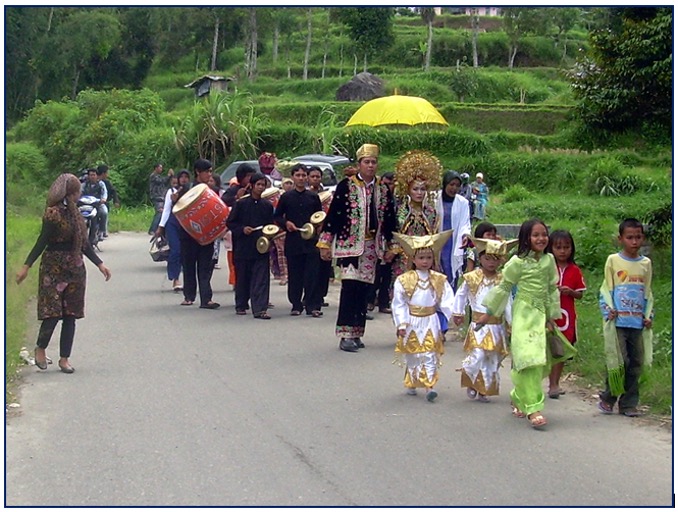Talempong Music in West Sumatra
Application of Tonalities in Traditional Minangkabau Music Performances
DOI:
https://doi.org/10.26721/spafajournal.i39kf22kkiKeywords:
Ethnic Minangkabau, Talempong, diversity of tuning system, ethnomusicologyAbstract
The ethnomusicological focus of this study is primarily directed at the musical traditions that are still alive and actively maintained by the community and its supporters. This study delves into the unwritten of realm music, especially music that is delivered orally, which is represented by the traditional metal talempong in the Minangkabau ethnic area. This study addresses issues and objectives that center on talempong as a characteristic or “icon” of traditional performing arts that develop in every village in the Minangkabau region, such as in Tanah Datar Regency; Agam Regency; Lima Puluh Kota Regency, Sijunjung Regency; and Solok Regency. The findings of the study on metal talempong music in Minangkabau reveal its significance as a cultural representation that symbolizes the Malay community in general. Talempong music serves as a key indicator of Minangkabau regional identity, recognized since ancient times throughout the entire archipelago. This study highlights interesting findings regarding the diversity of talempong existence today, emphasizing the “tuning” technique used by traditional cultural groups in Minangkabau. Where, this group relies on their senses, moods, and feelings to produce the distinctive sound of the metal talempong. In contrast, modern artists in Minangkabau approach the talempong “tuning technique” using Western diatonic instruments following established standards. Despite being influenced by modernity, traditional tuning methods persist in Minangkabau society, using a non-diatonic approach. Two striking basic techniques are the five-tone variant scale, synonymous with the Minangkabau musical tradition known as “limo Salabuan voice,” and the six-tone variant scale, associated with the Minangkabau musical tradition known as “onam Salabuan voice.”
References
Adam, B. A. (1970) Seni Musik Klasik Minangkabau, paper presented at the History and Culture of Minangkabau at Batusangkat region, Wes Sumateram Indonesia, 1-8 August.
Krader, B. L. (1955) Serbian Peasant Wedding Ritual Songs: A Formal, Semantic and Functional Analysis. PhD Thesis, Radcliffe College.
Manggis, M. R. and Pangulu, D. R. (1971) Minangkabau Sejarah Ringkas dan Adatnya (Minangkabau: A Brief History and Its Customs). Padang: Sridharma.
Nadra. (2006) Rekonstruksi Bahasa Minangkabau (Reconstruction of the Minangkabau Language). Padang: Andalas University Press.
Naim, M. (2007) Potensi Budaya Minangkabau dan Prospek Pengembangannya (Minangkabau Cultural Potential and Development Prospects). In: Y. S. Putra (ed.) Minangkabau Di Persimpangan Generasi (Minangkabau at the Crossroads of Generations). Padang: Pusat Studi Humaniora dan Fakultas Sastra Universitas Andalas, 92-102.
Navis, A. A. (1984) Alam Terkembang Jadi Guru: Adat dan Kebudayaan Minangkabau (Nature as a Teacher: Minangkabau Customs and Culture). Jakarta: Grafiti Pers.
Nursyirwan. (2011) Varian Teknik Penalaan Talempong Logam di Minangkabau (Variants of Metal Talempong Tuning Techniques in Minangkabau). PhD Thesis, Gadjah Mada University, Yogyakarta.
Radjab, M. (1969) Sistem Kekerabatan Di Minangkabau: Sebuah Case Studi dari segi Tinjauan Psikologi Sosial terhadap 102 Rumah Gadang di Sumpur, Padang Panjang (Kinship System in Minangkabau: A Case Study from the Perspective of Social Psychology Review of 102 Rumah Gadang in Sumpur, Padang Panjang). Padang: Center for Minangkabau Studies Press.
Rose, A. P. (1989) The Anthropology of Dance. Blangminton & London: Indiana University Press.
Sastra, A. I. (2015) Konsep Batalun Dalam Penyajian Talempong Renjeang Anam Salabuhan Di Luhak Nan Tigo Minangkabau (Batalun Concept in Presenting Talempong Renjeang Anam Salabuhan in Luhak Nan Tigo Minangkabau). PhD Thesis, Indonesia Art Institute, Surakarta.
Wardizal. (2022) Semarak Perkembangan dan Pertunjukan Tambua Tasa di Tengah Kehidupan Sosiokultural Masyarakat Selingkar Danau Maninjau (The Excitement of the Development and Performance of Tambua Tasa amid the Sociocultural Life of the Community Around Lake Maninjau). Journal of Music Science, Technology, and Industry 5(2): 339-361. E-ISSN: 2622-8211. Institut Seni Indonesia Denpasar.

Downloads
Published
How to Cite
Issue
Section
License
Copyright (c) 2025 SEAMEO SPAFA and Author

This work is licensed under a Creative Commons Attribution-NonCommercial-NoDerivatives 4.0 International License.



